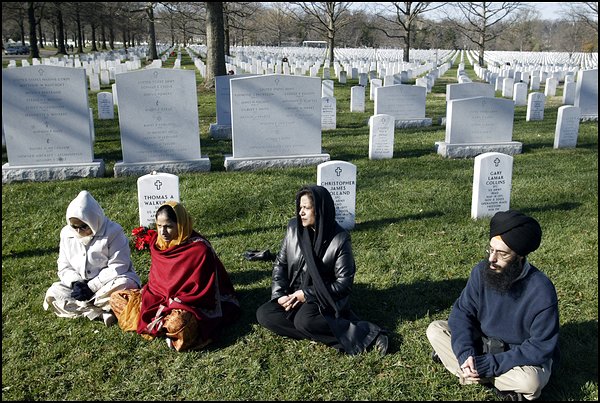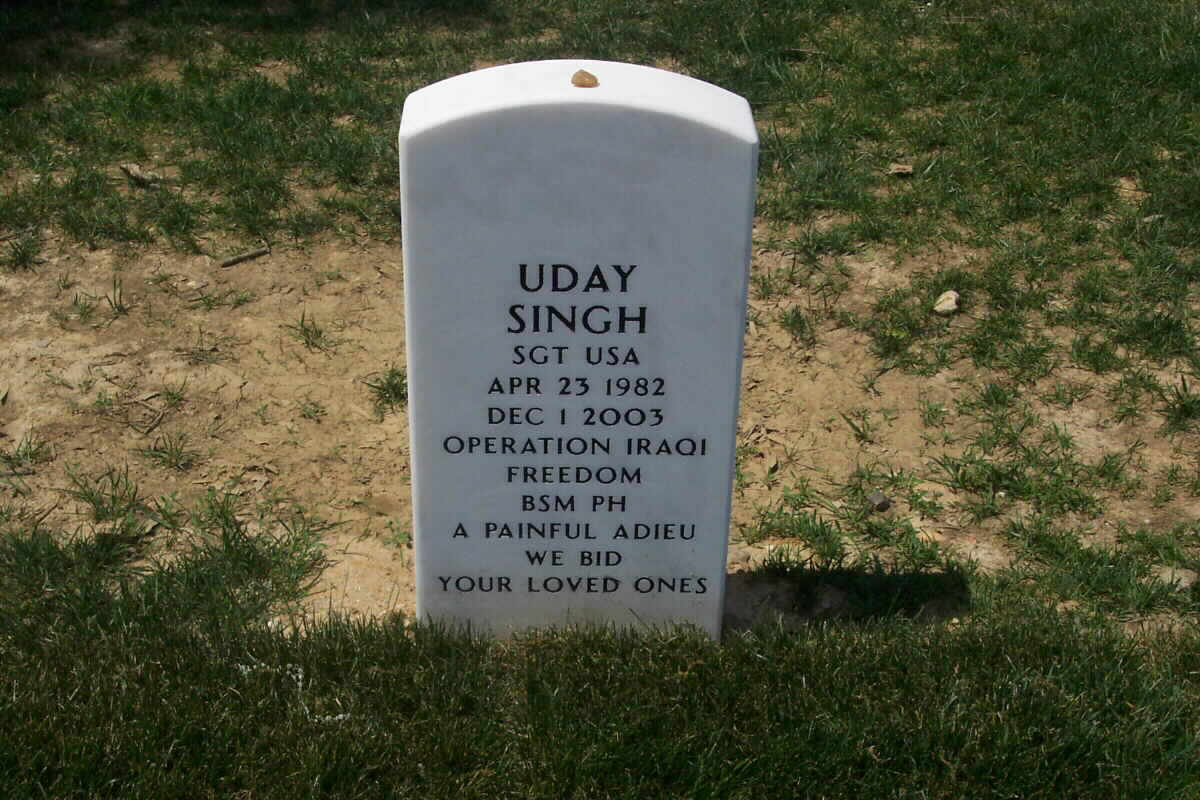IMMEDIATE RELEASE December 2, 2003
DoD Identifies Army Casualty
The Department of Defense announced today the death of a soldier who was supporting Operation Iraqi Freedom.
Specialist Uday Singh, 21, of Lake Forest, Illinois, was killed on December 1, 2003, in Habbaniyah, Iraq. Singh died of injuries sustained when enemy forces attacked his patrol.
Singh was assigned to C Company, 1st Battalion, 34th Armored Regiment, 1st Infantry Division, based in Fort Riley, Kansas.
The incident is under investigation.
Arlington bugler’s blue note
Honors fallen G.I.s
By RICHARD SISK
Courtesy of the New York Daily News
Sergeant Major Henry Sgrecci, the Army’s premier bugler, stood apart from the rifle squad to blow the 24 notes of taps last week at the burial of yet another soldier.
As always before playing, Sgrecci, 51, of upstate Watkins Glen, New York, offered the silent prayer he has uttered repeatedly as the slain return from Iraq to Arlington National Cemetery: “Please don’t let me make a mistake.”
Three times last Tuesday, the haunting sounds of Sgrecci’s gold-plated Vincent Bach brass bugle drifted across the hilly former homestead of Robert E. Lee, now a final resting place for fallen heroes.
On Thursday, Sgrecci played again, for the burial of an urn containing the cremated remains of 21-year-old Sereant Uday Singh of Chandigarh, India, who was living with an aunt in Lake Forest, Illinois, when he joined the U.S. Army in 2000.
The soldier from C Company, 1st Battalion, 34th Armored Regiment, 1st Infantry Division, based at Fort Riley, Kansas, was in the lead Humvee of a three-vehicle patrol that was ambushed December 1, 2003, near Habbaniyah, about 65 miles west of Baghdad.
Of the 496 U.S. troops killed in Iraq through last week, Singh was the 44th buried in Arlington, and the first Indian national.
As the mourners, many of them in the turbans and flowing beards of the Sikh tradition, took their places at graveside, Sgrecci removed his bugle’s mouthpiece and cupped it in his right hand to warm it in the sub-freezing cold.
“Your muscles can’t always know what to do, especially when it’s cold,” Sgrecci said. “Everybody knows the tune” he has performed thousands of times, “but it never gets old, because it’s the highest honor I can personally extend to a fallen comrade.”
With the barked command “ready, aim, fire,” the seven-member rifle squad loosed three shattering blank volleys in salute and Sgrecci raised his bugle with both hands.
At the grave, retired Indian Army Lieuteannt Colonel Preet Mahinder Singh, Uday Singh’s father, came to attention, his gray suit coat beribboned with the battle decorations of his own armor regiment.
Preet Singh would say later that his thoughts were of “my lost son, my only son. Uday was fun-loving,” and not as devoted to his schoolbooks as his father would have liked, but “he was a good son, a very obedient boy. He was a very brave soldier. He did his duty.”
But now, the father squared his shoulders in the direction of Sgrecci as the bugler played.
The notes did not begin so much as grow and swell from the bugle’s bell, gaining strength as they rose in pitch and lengthening as they fell.
The tune was adapted by Union Army Major General Daniel Butterfield from the bugle call for “Extinguish Lights.”
With the help of his 22-year-old bugler Oliver Wilcox Norton, Butterfield revised an earlier bugle call. Soldiers spread it throughout the Army grapevine until it became universal. Butterfield is remembered in a statue near Grant’s Tomb, though there is no mention of his connection to taps.
In his own renditions, Sgrecci said, “I am never, ever not motivated to do my absolute best.”
His last note played for Uday Singh lingered so long that the flag team hesitated before beginning its folding drill, not seeming to know the tune was over until Sgrecci lowered the bugle.
Brigadier General Mark O’Neill presented Preet Singh with citations that posthumously awarded Uday Singh the Bronze Star for valor, promoted him to sergeant and made him a citizen of the nation for which he gave his life.
Then a Sikh holy man stepped forward for the ritual singing of the “Shabad Keertan,” a hymn from Sikh scripture.
In one of Uday Singh’s last E-mails, Preet Singh said his son wrote to his family: “You guys have fun while I go save the whole world. P.S. Pray for me.”
The father said his son loved fast cars and bikes.
“He was a boy who loved action and ultimately gave up his life for his love to be where action is,” Preet Singh said.
“On December 1, we lost our precious son,” the father added, “but at that same instant, two nations had adopted him as their own – India and the U.S. Uday has touched many hearts and he has made them proud.”
Fitting farewell to Uday Singh
TURSDAY, JANUARY 1, 2004
The official memorial service for Uday Singh, the U.S. soldier of Indian origin who died in Iraq last month, will be held at the Sikh gurdwara in Palatine, Illinois, on January 17, 2004.
Singh’s parents have flown in from Chandigarh, India, to attend his last ceremonies in Washington DC, Chicago and Illinois.
In Washington DC the rites will be held at the Arlington National Cemetery on January 8, 2004.
Illinois Lieutenant Governor Pat Quinn will lead the homage ceremony at Palatine. Singh will be posthumously awarded U.S. citizenship at the ceremony.
The Goldstar Mothers’ Association will present the Gold Star Banner to Singh’s mother Manjit Kaur and his aunt Harpreet Datt, who was his local guardian in the U.S.
A large number of socio-cultural and charitable organisations of the Indian community are organising the Palatine service.
H.S. Chawla, president of the Palatine gurdwara, has appealed that “more and more numbers of organisations and members of the Chicago community must come and pay glorious tribute to the son of the Sikh community who fought valiantly and sacrificed his life for the U.S”.
Singh was killed in Habbaniyah in Iraq December 1, 2003, while serving as a gunner with the U.S. Army. He was cremated with U.S. military honors in Chandigarh.
Born and brought up in Chandigarh, Singh migrated to the U.S. in the 1990s and lived with his uncle Prem Datt and aunt Harpreet in Lake Forest, Illinois. He enlisted in the U.S. Army in August 2000.
Thursday December 18, 10:15 PM
Uday Singh’s remains to be buried at Arlington cemetery
By Vasantha Arora, Indo-Asian News Service
Washington, December 18, 2003 (IANS) The ashes of Uday Singh, the India-born U. S. soldier who died in Iraq this month, will be buried at the Arlington National Cemetery in Virginia beside other fallen soldiers during a service to be held on January 8, 2004.
Singh was the first Indian casualty of the war. He died on December 1, 2003, after an attack on his unit in Habbaniyah.
He was cremated in his hometown of Chandigarh, the twin capital of the Indian states of Haryana and Punjab, with full military honours. This was the first time a foreign military held a ceremonial funeral for one of its soldiers in India.
Several family members, including Singh’s parents, sister and grandmother, are expected to arrive from India to attend the ceremony at the Arlington National Cemetery.
Singh has left an indelible mark on his Sikh community, which is hailing him as a hero and martyr and is doing its best to perpetuate his memory.
A website and a scholarship fund is being set up in his name, according to media reports here.
Sikhs living in Chicago will hold a memorial service in Singh’s honour January 17, 2004, at the Palatine gurdwara that hundreds are expected to join.
The website in memory of Singh is being set up by the Sikh American Heritage Organisation and Punjabi Cultural Society of Chicago, where people can send in their condolences.
According to Mohinderjit Singh Saini, managing director of the Punjabi Cultural Society, a memorial scholarship fund is being planned to perpetuate Singh’s memory as a role model for the next generation.
A permanent memorial for him at a public location in Lake Forest or Palatine is also being considered, according to the Punjabi Cultural Society.
The Daily Herald, published from Chicago, quoted Prem Jay Datt of Lake Forest, his uncle and guardian in the U.S. as saying, “We expect there would be many people (at the memorial service) who would want to celebrate Uday’s life and share in the family’s sorrow.”
The family has received over 150 messages of sympathy from friends and neighbours in the Lake Forest community, and several hundred more from strangers.
The Palatine service will include the ritual singing of hymns, “Shabad Keertan”, from the Sikh holy scripture Sri Guru Granth Sahib. This will be followed by a discourse on martyrdom and prayers.
According to Sikh tradition, when a person dies on the battlefield, he or she becomes a martyr, explained Sukhchain Singh, dean and administrator of the Sikh Religious Society at Palatine gurdwara.
For the Chicago Sikh community, Singh personifies what it means to be a war hero.
“Sikh tradition is a combination of two thoughts – we are saints and we are soldiers,” Sukhchain Singh said. “It is a combination of sainthood and the fighting spirit. But fighting must always be for a good cause.”
A soldier is gone
Suburban Sikh, 21, is killed while fighting for U.S. in Iraq
A 21-year-old immigrant had hoped to realize his dream of becoming an American citizen and attending college after his Army enlistment ended.
But that won’t happen.
U.S. Army Specialist Uday Singh died in battle after his tank patrol was attacked Dec. 1 in Habbaniyah, Iraq. He is listed among the 520 confirmed coalition deaths, including 446 American soldiers, Marines, airmen and sailors, in the war in Iraq who have died as of December 5, 2003. He is the first casualty from Lake County.
Singh was raised in India and decided he wanted to live in America when he was 16 and visiting his aunt and uncle in Lake Forest, Illinois.
“He realized the wonderful opportunity offered by this country and said he was going to come back and make his life here,” said Prem Jay Datt, his uncle and guardian who has lived in Lake Forest for 33 years and attends the Sikh Religious Society in Palatine.
Palatine memorial
Palatine Zoning Board of Appeals member Moh Saini said Singh sometimes attended services at the Palatine Sikh temple with his aunt and uncle. Saini said temple members plan to hold a January 11, 2004, memorial service for Singh, but the details are not finalized.
Singh decided to enlist in the U.S. Army to achieve his goal after he learned the process was much shorter for veterans of the U.S. military.
From Iraq, he sent many upbeat letters.
“I have good news!” said one letter from the young private. “In a couple of months I shall be a ‘sarge’!
“More good news,” he continued. “My citizenship process has finally gone through and I have to get fingerprinted January 14 (2004), and they will try and send me back (to the United States) for a couple of weeks. I get your mail frequently and the letters have kept me going.”
As a teenager, Singh use to ride his bike along Waukegan Road to reach a summer job at the McDonald’s located on Waukegan Road north of Route 176.
“That really gave him a taste of American freedom,” his uncle recalled.
He wrote his family in India outlining his plan to join the army.
“They approved,” Datt said. “My nephew came from a military family. His late grandfather was a decorated World War II veteran originally in the Royal British Air Force and later the Indian Air Force.”
Singh met with recruiters and enlisted at 18. He was sent to Fort Knox, Kentucky, for boot camp. He was posted at Fort Riley, Kansas, and assigned to C Company, 1st Battalion, 34th Armored Regiment, 1st Infantry Division. In early 2002 he was stationed in Kuwait for four months and then returned to Lake Forest.
Singh wanted to study business in college. Fast-tracking the citizenship process and being eligible for the promised financial assistance from the military for college education were his main reasons for re-enlisting.
Before being deployed to Iraq in mid-September, Singh started working toward a business degree by accumulating college credits from courses he was able to take over the Internet.
Singh wrote to his aunt and uncle about the fighting.
“Our company has 13 Purple Hearts already. CNN said we were scheduled to come (home) in the spring, so let’s see how that goes.”
Singh also kept up with the news at home and commented on the commitment of Congress to spend billions of dollars for the rebuilding of Iraq.
“It’s being put to good use,” he wrote. “We got running water, power and cable television.”
As with most service people, he anxiously awaited mail and packages from home.
“After a few days, thanks to you (the aunt and uncle), we’ll have a volleyball court! Everyone is so excited.”
But then two days before his death last week, his Lake Forest family received another letter. The young tank driver expressed the growing fear he began to experience as the guerilla warfare took a greater toll on the troops.
“I have never been so scared in my whole life. The first time we got into a firefight, my body was drenched in sweat and I was shaking so much it was unimaginable. Now I have gotten used to it, even though it shakes me up every time. I think the enemy is finding a new place for operations where there is not so much offensive from our side.”
He then recalled a mission to Baghdad, about one and a half hours away from his camp.
“We stayed at one of Sadaam’s palaces. It was just amazing and beautiful. There were lakes and animals all over the place and in the back yard. I just wonder what was going on in those palaces a year ago,” he wrote.
Citizenship
Datt’s relatives learned the young soldier was scheduled to be sworn in as a citizen next month. His family hopes the United States would convey the special honor posthumously. Datt learned both U.S. Sen. Dick Durbin and U.S. Rep. Mark Kirk, R-10th, were working to accelerate the process.
“Pvt. Singh’s paperwork is in order and his application should move to the top of the list,” Kirk said Friday. “That is the least we can do.”
Legal immigrants now only need to serve in the military before applying for citizenship, he explained.
“It means becoming a citizen five years quicker if you are wearing the uniform,” Kirk said.
History shows legal immigrants have been an important part of military defenses for more than 200 years.
“Probably the classic experience is when the Union army met Irish immigrant boats in New York and recruited young Irishmen stepping off the boat into the Union army,” Kirk said.
In Lake Forest, the McKinlock American Legion Post 264 presented Singh’s relatives with the gold star window banner that denotes a service man or woman died on the battlefield.
“If a blue star appears on the banner, it means someone in the residence is a member of the armed forces,” said post member Bill Malich. “If it is gold, it means the person has died.”
Singh’s family will decide whether the special honor will be displayed at the Lake Forest home or the family residence in India.
In addition to his Lake Forest family, Singh is survived by his father Preet Mahinder Singh; his mother, Manjit Kaur Singh, and a sister Banni who all live in India.
The Army hero’s body will be flown to Dover Air Force Base in Delaware. From there the casket will be escorted to India where it be accorded full military honors. He will be cremated as part of the Sikh religion.
Because the serviceman died in battle, his remains are eligible for burial in the Arlington National Cemetery. It is a decision to be made by his father and mother.
Thursday December 11, 5:30 PM
America’s soldier, India’s son cremated with US honours
By Indo-Asian News Service
Chandigarh, India – December 11, 2003 – In what was the first time that a foreign army held a funeral ceremony in India, a young U.S. Army Sergeant who died in Iraq was Thursday cremated in his hometown here with full US honors.
It wasn’t the tricolour that the body was draped in, but the stars and stripes. It wasn’t The Last Post that was played, but Taps, its U.S. Army equivalent.
And both India and the US mourned the loss of Uday Singh, the 21-year-old U.S. Army sergeant of Indian origin – an American hero and an Indian son.
The funeral pyre was lit by Uday’s father Preet Mohinder Singh, a former Indian Army officer, in the presence of grieving relatives, friends and the Commander of the U.S. Army’s Pacific Command Lieutenant General James Campbell, who had flown in specially from Hawaii.
Uday’s body was flown from the US in a commercial airline to New Delhi from where it was brought to his home here by road around 10 a.m.
The coffin draped in the US flag was brought out from the vehicle and a group of U.S. soldiers folded the American flag into a triangle.
Campbell handed over the flag to Uday’s father after laying a wreath on the coffin.
The U.S. soldiers then presented a guard of honor to Uday, whose body was draped in “Class A” uniform, by firing a volley of shots.
Indian Army soldiers belonging to the Western Command here, who were loaned for the ceremony, sounded the bugle playing Taps.
There was pin drop silence during the funeral ceremony as Uday’s relations, including his grandmother and 11-year-old sister, Bani, watched with their eyes glistening with tears.
Addressing the Singh family and the gathering of their relations and friends, Campbell said: “Sergeant Uday Singh was and always will be an American soldier. He always placed the mission first. He never accepted defeat and he never quit.
“He is our hero. Today, we stand tall as a nation and an army and in our grieving take enormous pride in saluting Sergeant Uday Singh for his noble stance to make the world safer, his sense of honour and commitment and his loyal and faithful service to our country.”
Playing glowing tributes to “a brother in arms and India’s son”, the U.S. general said: “Today, two great democratic nations pause and mourn the loss of this courageous young man who chose the life of a soldier.
“In so doing, he knew fully well that he could be called upon to place his life on the line in order to give people, who have only known tyranny and despair, a chance to be free and to control their own destiny.”
Campbell said in Uday’s loss the world was reminded once again that freedom was not free and it was paid for in blood, sweat, tears and in the lives “of our most treasured resources – our sons and daughters in uniform.”
Praising the rich military tradition of the Singh family, he described Uday as an extraordinary soldier like his father.
“Poised, professional, dedicated to both his missions and to his fellow soldiers, previously decorated for his services in Kuwait, he also was a magnificent role model and a standard setter for his entire company.”
Campbell said the motto of the first infantry division was – “no mission too difficult. No sacrifice too great – duty first”. And Uday epitomised that spirit.
The US general left after spending about two hours in the Singh household, which was cordoned off by the police for security reasons.
Other than Campbell and the US soldiers, several officials from the US embassy in New Delhi were present. They included Deputy Chief of U.S. Mission Walter North and US Defense Attaché Steven Sboto.
Uday’s ashes would be flown to Arlington National Cemetery near Washington where the U.S. Army wanted to bury his body.
Uday passed his Class 12 examinations from this city’s St. Stephen’s School in 2000 and headed straight for the U.S. to enlist in the army.
He was killed in Habbaniyah in Iraq on December 1, 2003, while serving as a gunner in the US forces – which he had joined only three years ago much against his mother’s wishes.
He was the first Indian in the US Army to have been killed in Iraq.
Uday’s funeral service to be as per U.S. Army traditions
Tribune News Service
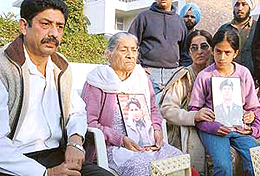
and sister Bani at their house in Sector 18 in Chandigarh on Thursday.
Chandigarh, India: December 4, 2003:
The funeral of Sergeant Uday Singh, who died in Iraq on December 1, 2003, while serving with the U.S. forces, will be held here with full service honours, with a contingent from the U.S. army being flown in here for the purpose.
Stating this here today, Steven J. Stoiber, a defense attache with the U.S. Embassy in New Delhi, India, said the contingent was expected to be led by an officer of the rank of Brigadier General. The services would be as per the U.S. Army traditions.
For the family, it will be a tortuous wait as it would take at least a week before Uday’s body arrives here because there are many formalities to be completed. The body has been taken to Dover, Delaware, for an autopsy. After being embalmed, the body will be draped in the soldier’s “Class-A” uniform, complete with service medals and regimental regalia before being airlifted to Chandigarh.
This is perhaps for the first time in Independent India that a foreign army would be conducting a service funeral. Later, Uday’s ashes would also be taken to the Arlington National Cemetery in Virginia near Washington, where the US buries it war dead.
The U.S. authorities had earlier asked Uday’s father, Lieutenant Colonel P.M. Singh (retired), whether Uday should be buried at Arlington or his last rites be performed in Chandigarh. Steven, who refused to disclose his rank, is performing the role of casualty assistance officer, whose job is to stay with the bereaved family until the funeral is over and assist the family. The U.S. Embassy’s media adviser, Ms Arti Singh, is also here and is expected to stay until all formalities are completed.
Speaking to media-persons at his Sector 18 residence, Colonel P.M. Singh and his wife, Manjit said their son had not been afraid to fight in Iraq. With tears, she recalled her son’s last words to her a few days ago, when he had said he was proud to be in the US army and that nothing could happen to him. She said she had been against Uday joining the U.S. Army.
Enlisted into ‘C’ Company, 1st Battalion, 34th Armoured Regiment, Uday was killed after his patrol had been ambushed near Habbaniyah. He was evacuated to the Forward Operating Base, St Mere, where he succumbed to his injuries. He had been a gunner onboard a Hummvee, which left his torso exposed.
The 21-year-old trooper hailed from a military family, with his father having served in the Indian Army and his grandfather having served in the Royal Indian Air Force during the colonial era. Uday’s father said his son had proved himself as a soldier, having been awarded the Army Achievement Medal when his company was deployed in Kuwait in 2001. He had moved to Iraq in September 2003.
His home was crowded as relatives, friends and associates poured in to express their condolences. His friends recalled that Uday loved fast cars, war movies and was keen on joining the US army. He had spoken to some of his friends a few days ago. An alumni of St Stephen’s School, from where he did his Class XII, one of his teachers said he was focussed about his career.
Uday’s 87-year-old grandmother, Anup Kaur, to whom he had written last month describing the conditions prevailing on the battlefield, trying to overcome emotions, said Uday had brought honour to a military family by sacrificing his life. Uday’s 11-year-old sister Bani was brought home from Sanawar, where she is studying in Class VII.
Chandigargh, India – A U.S. soldier killed in Iraq has been given full military honors at a funeral in his hometown in India.
Twenty-one-year-old Army Sergeant Uday Singh was killed December first in an ambush on his convoy. He would have become a U-S citizen next month.
About 100 of his family and friends gathered in his hometown today to remember him. His coffin was escorted by a military honor guard led by Lieutenant General James Campbell. Campbell said two great nations pause to mourn a courageous young man. He said Singh’s loss is a reminder “once again that freedom is not free.”
After the service, Singh’s body was taken to a funeral home for religious rights and cremation. His ashes will be flown to Arlington National Cemetery in Virginia.
Singh’s father is a retired colonel in the Indian army and says his son would want to be laid to rest alongside “his buddies” who also died in Iraq.
Sunday, December 5, 2004
Courtesy of the Washington Post
The grave marker in the front row of Section 60 of Arlington National Cemetery looks like almost every other marker in that precise arrangement on the grassy burial ground, but for Sikhs, it is one of a kind.
Under that gray-white headstone lies Sergeant Uday Singh, the first U.S. soldier of the Sikh faith killed in the war in Iraq. A group of three dozen Sikh people from the area came yesterday morning to honor the first anniversary of the 21-year-old Army gunner’s death in Iraq with a modest service, and just as important, to remind the rest of the world that Sikhs are Americans.
“This is pretty emotional for me, what he gave and what he represents,” said Army Staff Sergeant Hardeep Singh, 32, a Sikh mourner from McLean who joined the memorial in the blustery cold while on six-month leave after being stationed in Kuwait.
After the September 11, 2001, terrorist attacks, many Sikhs said their fellow Americans viewed them with suspicion, wrongly assuming they were Muslims because of the turbans that Sikh men wear as part of their religion. College students at the service yesterday recalled how some drivers on the highway confused them for members of the Taliban in Afghanistan because of the similar black headdress.
And so the anniversary service served two purposes. It was a way for local Sikhs, most from Guru Gobind Singh Foundation in Rockville, to pay tribute to Uday Singh and his family. And it helped them show their pride that a Sikh had sacrificed his life in battle for his fellow Americans.
“I believe our roots in this country are strengthened by the sacrifices of people like Uday Singh,” Rajwant Singh, chairman of the Washington-based Sikh Council on Religion and Education, told the group huddled against the cold. “Sikhs are not only enjoying the freedoms and benefits of this country, but we are also willing to sacrifice our lives for this country.”
Uday Singh was born in India but moved with his family to Lake Forest, Illinois, in 1998. Singh, who was from a military family, chose to enlist in the Army in the summer of 2000 rather than enroll at the University of Illinois. On November 23, 2003, he and members of his patrol were killed when their Humvee convoy was attacked by insurgents in the town of Habbaniyah.
Singh’s parents sent letters to the Sikh mourners a few weeks ago to thank them for commemorating the anniversary of their son’s death.
His death has a special resonance for Hardeep Singh, who struggles to make his ethnic identity clear to other Americans even though he’s the fourth generation of Sikhs to settle in the United States.
“My dog tags still say {grv}other,’ ” he said. “Some people think I’m Muslim. Sometimes I get Spanish. I tell the other soldiers: {grv}Remember, I’m Indian. I’m brown. Don’t shoot me.’ ”
The youths at the ceremony wore the typical trappings of U.S. teenagers — Old Navy fleece jackets and designer boots. But they carried their heritage as well, leading their parents and fellow churchgoers in a centuries-old battle cry that Sikhs yelled when fighting Moguls who were trying to forcibly convert everyone to Islam.
“Whoever replies to this chant . . . ” the children shouted in the Punjabi language.
“Let them be victorious!” the adults responded.
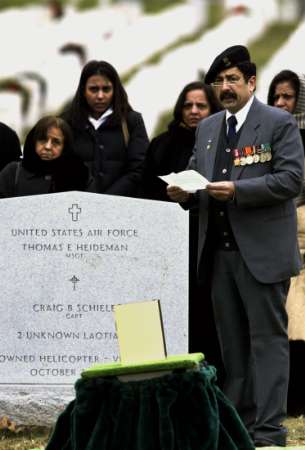
Uday Singh at Arlington National Cemetery, January 8, 2004.
Singh was killed December 1, 2003 while on patrol In Habbaniyah, Iraq
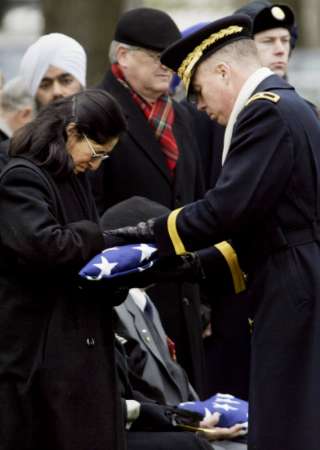
Mark O’Neill during the burial ceremony of U.S. Army Specialist Uday
Singh at Arlington National Cemetery, January 8, 2004.
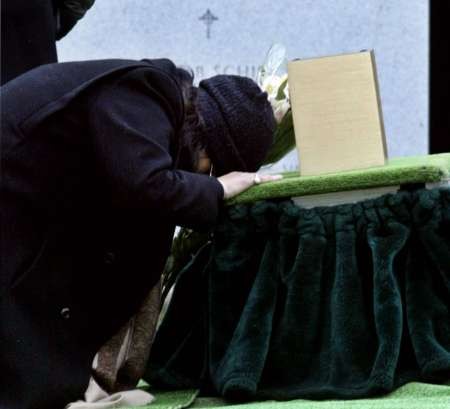
SINGH, UDAY
- SGT US ARMY
- DATE OF BIRTH: 04/23/1982
- DATE OF DEATH: 12/01/2003
- BURIED AT: SECTION 60 SITE 8122
- ARLINGTON NATIONAL CEMETERY
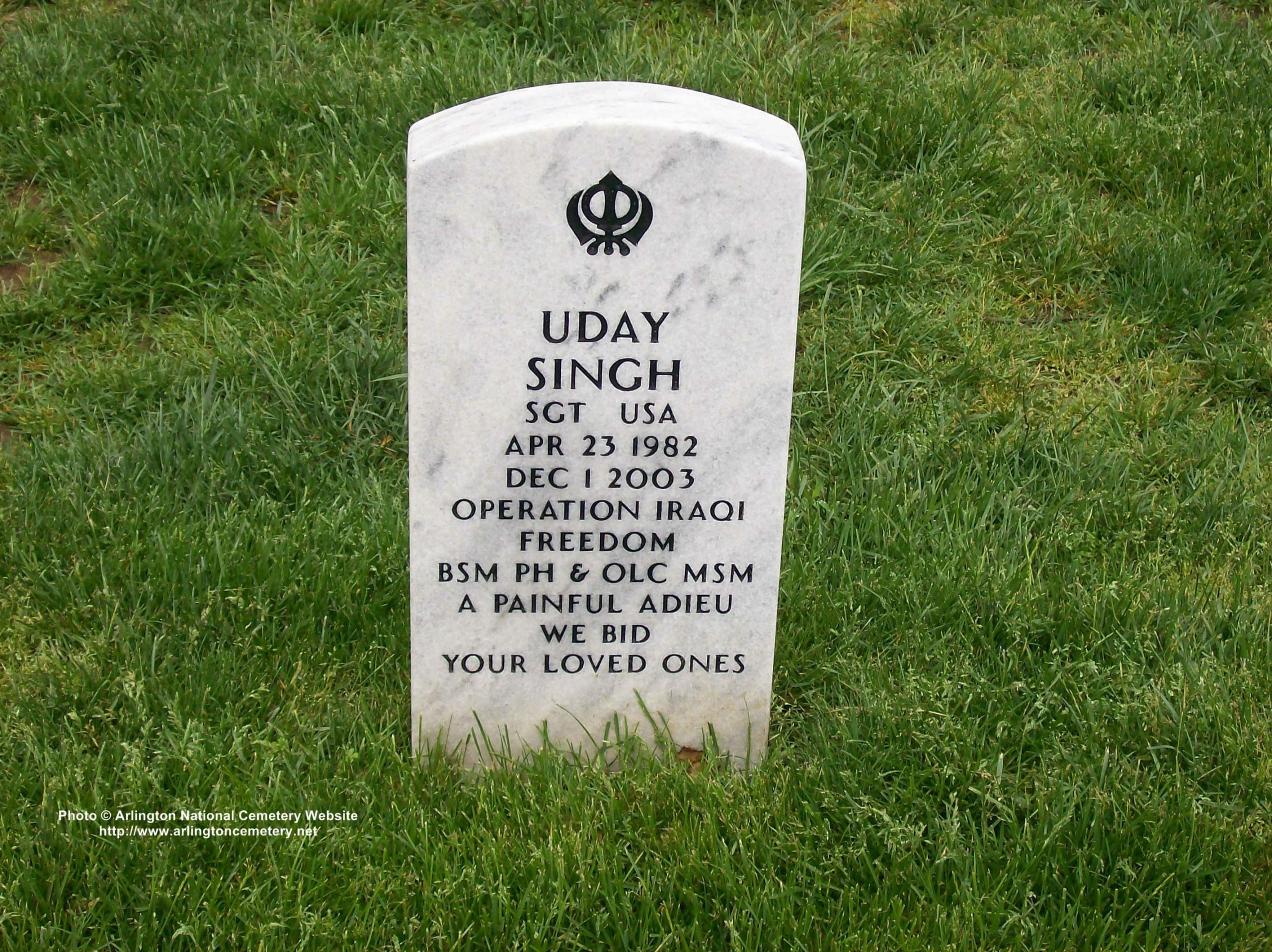
Michael Robert Patterson was born in Arlington and is the son of a former officer of the US Army. So it was no wonder that sooner or later his interests drew him to American history and especially to American military history. Many of his articles can be found on renowned portals like the New York Times, Washingtonpost or Wikipedia.
Reviewed by: Michael Howard

